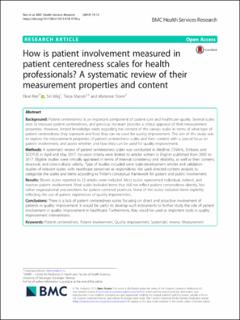| dc.contributor.author | Ree, Eline | |
| dc.contributor.author | Wiig, Siri | |
| dc.contributor.author | Manser, Tanja Nicole | |
| dc.contributor.author | Storm, Marianne | |
| dc.date.accessioned | 2020-05-20T09:13:46Z | |
| dc.date.available | 2020-05-20T09:13:46Z | |
| dc.date.created | 2019-01-09T11:12:05Z | |
| dc.date.issued | 2019-01 | |
| dc.identifier.citation | Ree, E., Wiig, S., Manser, T., Storm, M. (2019) How is patient involvement measured in patient centeredness scales for health professionals? A systematic review of their measurement properties and content. BMC Health Services Research, 19. | en_US |
| dc.identifier.issn | 1472-6963 | |
| dc.identifier.uri | https://hdl.handle.net/11250/2655106 | |
| dc.description.abstract | Background
Patient centeredness is an important component of patient care and healthcare quality. Several scales exist to measure patient centeredness, and previous literature provides a critical appraisal of their measurement properties. However, limited knowledge exists regarding the content of the various scales in terms of what type of patient centeredness they represent and how they can be used for quality improvement. The aim of this study was to explore the measurement properties of patient centeredness scales and their content with a special focus on patient involvement, and assess whether and how they can be used for quality improvement.
Methods
A systematic review of patient centeredness scales was conducted in Medline, CINAHL, Embase, and SCOPUS in April and May 2017. Inclusion criteria were limited to articles written in English published from 2005 to 2017. Eligible studies were critically appraised in terms of internal consistency and reliability, as well as their content, structural, and cross-cultural validity. Type of studies included were scale-development articles and validation studies of relevant scales, with healthcare personnel as respondents. We used directed content analysis to categorize the scales and items according to Tritter’s conceptual framework for patient and public involvement.
Results
Eleven scales reported in 22 articles were included. Most scales represented individual, indirect, and reactive patient involvement. Most scales included items that did not reflect patient centeredness directly, but rather organizational preconditions for patient centered practices. None of the scales included items explicitly reflecting the use of patient experiences of quality improvement.
Conclusions
There is a lack of patient centeredness scales focusing on direct and proactive involvement of patients in quality improvement. It would be useful to develop such instruments to further study the role of patient involvement in quality improvement in healthcare. Furthermore, they could be used as important tools in quality improvement interventions. | en_US |
| dc.language.iso | eng | en_US |
| dc.publisher | BioMed Central | en_US |
| dc.rights | Navngivelse 4.0 Internasjonal | * |
| dc.rights.uri | http://creativecommons.org/licenses/by/4.0/deed.no | * |
| dc.subject | pasientsikkerhet | en_US |
| dc.subject | pasientmedvirkning | en_US |
| dc.title | How is patient involvement measured in patient centeredness scales for health professionals? A systematic review of their measurement properties and content | en_US |
| dc.type | Peer reviewed | en_US |
| dc.type | Journal article | en_US |
| dc.description.version | publishedVersion | en_US |
| dc.rights.holder | © The Author(s). 2019 | en_US |
| dc.subject.nsi | VDP::Medisinske Fag: 700 | en_US |
| dc.source.pagenumber | 13 | en_US |
| dc.source.volume | 19 | en_US |
| dc.source.journal | BMC Health Services Research | en_US |
| dc.identifier.doi | 10.1186/s12913-018-3798-y | |
| dc.identifier.cristin | 1653049 | |
| dc.relation.project | SHARE - Centre for Resilience in Healthcare: 5091 | en_US |
| dc.relation.project | Norges forskningsråd: 256681 | en_US |
| cristin.ispublished | true | |
| cristin.fulltext | original | |
| cristin.qualitycode | 2 | |

